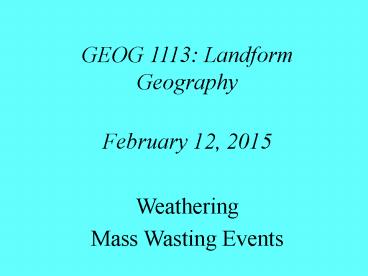GEOG 1113: Landform Geography - PowerPoint PPT Presentation
1 / 24
Title:
GEOG 1113: Landform Geography
Description:
Title: Slide 1 Author: Lawrence McGlinn Last modified by: Georgina DeWeese Created Date: 12/28/2006 2:09:16 AM Document presentation format: On-screen Show (4:3) – PowerPoint PPT presentation
Number of Views:71
Avg rating:3.0/5.0
Title: GEOG 1113: Landform Geography
1
GEOG 1113 Landform Geography February 12,
2015 Weathering Mass Wasting Events
2
Weathering
- Process by which rocks break down into smaller
pieces - Two Primary Types
- Mechanical (or physical) cold, dry environments
- Chemical warm, moist environments
3
Mechanical Weathering
- Destruction of rock through physical stresses
- Rocks break into small pieces surface area of
rock increases even greater weathering - Types
- Frost Wedging
- Impact of Roots
- Temperature Fluctuations
- Salt Crystal Growth
- Exfoliation
4
Frost Wedging
5
Impact of Roots
6
Temperature Fluctuations
7
Salt Crystal Growth
8
Exfoliation
9
Chemical Weathering
- Changes rock by altering its chemical composition
water particularly important - Types
- Hydrolysis
- Oxidation
- Carbonation
- Acid Rain
10
Hydrolysis
11
Oxidation
12
Carbonation
13
Acid Rain
- Coal-burning power plants in Midwest emit sulfur
dioxide (SO2) nitrogen oxides (NOx) - SO2 NOx mix with water in clouds to form
sulfuric or nitric acid - Clouds move east where acid rain falls
- Acid rain accelerates chemical weathering
- Acid rain can also harm lakes forests
- Regulation has cut acid emissions dramatically
14
Effects of Acid Rain
- The ecological effects of acid rain are most
clearly seen in the aquatic, or water,
environments, such as streams, lakes, and
marshes. - Most lakes and streams have a pH between 6 and 8,
although some lakes are naturally acidic even
without the effects of acid rain. - Buffering capacity
- Nitrogen is an important factor in causing
eutrophication (oxygen depletion) of water
bodies.
15
Mass Wasting
- Large volumes of sediment moving down hill slopes
under force of gravity - Types
16
Solifluction
17
Earth Flow
18
Mudflow
19
Debris Flow
20
Slump
21
Debris Slide
22
Soil Creep
23
Rockfall
24
Avalanche































